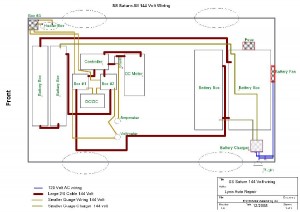The SS Saturn has installed in it eighteen 8 volt deep cycle golf cart batteries. They are rated at 150 ampere hour (this would be equal to a 200 ampere hour 6 volt battery in wattage ).
This rating is based on a 20 hour discharge, so this means “How many amps can it sustain for 20 hours”. Don’t be confused when doing the math, this number ‘150’ means 7.5 amps for 20 hours. Now the higher the rate of discharge the lower the ampere hour rating. This same battery cannot put out a full 150 amps for one solid hour (Peukert effect). Note: Practical battery capacity usage is 60 to 80% of the ratings.
Now their rating of “RC MIN@56AMPS” is 110 minutes (one hour and 50 minutes). This is a more pertinent specification in the EV world. This reserve capacity means the 8 volt battery can stay above 7 volts (126 volts, in series, in my case) up to 110 minutes while drawing a constant current of 56 amps.
There are many articles and Equations explaining this much better than I. I hope that in the spring with warm weather,without heater going and the batteries broken in I can do the 50 miles expected. But as of now, late December, 35 will do.
Battery Specifications for the Similarly Stimulated Saturn: 18, Exide 8 volt deep cycle golf cart batteries.
|
Type
|
RC Min@56A
|
RC Min@25A
|
Length
|
Width
|
Height
|
Ah.CAP20hr
|
Weight
|
|
GC8V-110
|
110
|
290
|
10-5/16″
|
7-1/8″
|
11-7/16″
|
150Ah
|
63 pounds
|
A good Battery Comparison Charts can be found here at Electric Vehicle Discussion List
Some terms used…..
Volt: Available Electrical Energy (like pressure)
Amps: Current or electrical measurement of amount of flow, equals volts X Ohms
Ohms: Resistance
Watts: Volts X Amps, a measure of electrical energy or work (eg 12volt X 100Amp=1200watt or 144volt X 8.33Amps = 1200watt)
Battery Capacity: Measured in Ampere Hours or better in Reserve Capacity Minutes
Peukert effect
Ampere-Hour: the electric charge transferred by a steady current of one ampere for one hour
Kilowatt Hour:a unit of energy equal to the work done by a power of 1000
watts operating for one hour
Ohm’s Law: The ratio of the potential difference between the ends of a conductor to the current flowing through it is constant. This constant is the resistance of the conductor
Coulomb: 1 coulomb equals 6,000,000,000,000,000,000 Electrons (or equivalent charged particles), a unit of electrical charge transferred by a current of 1 ampere in 1 second.
Analogies about electricity
are needed for me when I am trying to understand this entity of nature.
First analogy
Here is EVer James Edmondson’s explanation …….
Amps, Volts and Watts. The way I explain these …. is that the amount of volts I have is equivalent to the amount of gas in the tank of an ICE vehicle. This is my potential energy supply. I can use it up going to walmart, hauling people around, or at the drag strip. Amps are the rate at which I use my fuel. Going to wal mart at low speed used less amps than hauling around a bunch of people (weight), The drag strip will take even more amps to go fast really quick. In each case my moment by moment energy requirements vary and my usage rate (amps) varies accordingly. Think of it as the gas flow into the injectors…its just electrons to the controller. Watts is what you determine after the fact. I may use 4K watts of energy driving to wall mart 20 miles at 30 mph or going 110 mph in the quarter mile at the strip. My “gas tank” can’t tell what I did with that energy, it just knows it is gone. But, I know what work I did with that energy which is what watts are meant to measure. Now I know that my explanation will break down under technical scrutiny but for most people unfamiliar with the V=IR and VA=W equations or electrical flow this will usually satisfy them.
Second analogy
My analogy of electricity ……. water supply
Volts is Available Electrical Energy, like a garden hose might have 80 psi pressure with the spicket off.
Amp is current or the electrical measurement of the amount of flow, it equals volts X Ohms, like a garden hose when the spicket is on has a flow of gallons per minute.
Watt is Volts X Amps, a measure of electrical energy or work. If you had very high pressure (volts) and low volume (amps) coming out of a hose ( like at a car wash nozzle) it could spin a water wheel as fast as if the pressure (volts) was low but the volume (amps) was high, like slowly pouring out of a large pipe or hose.
So when defining watts or work done, high pressure and low volume equals low pressure and high volume or watts equals watts equals watts.



If this battery pack is rated at 150 amp-hour and a standard formula in DIY EV “EVs using Lead Acid batteries will only be able to use about 55% of the energy of the 20hr amphour rate” is 55% we have 82.5 amphour at 144 volts equals 11,880 watthours or about 12 KWatts.
If the Saturn draws 150 amps to travel 60 mph (150 amps X 144 volts) that would be 21,600 watts. It would travel 60 miles in an hour equals 1 mile a minute. So 1/60 of 21,600 watts equals 360 watts (watt hours) a mile.
360 watts a mile (2.5 amp hours a mile) using up the available 11,880 watt hours equals 33 miles maximum distance per charge. :- |